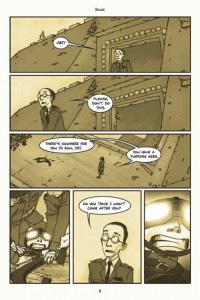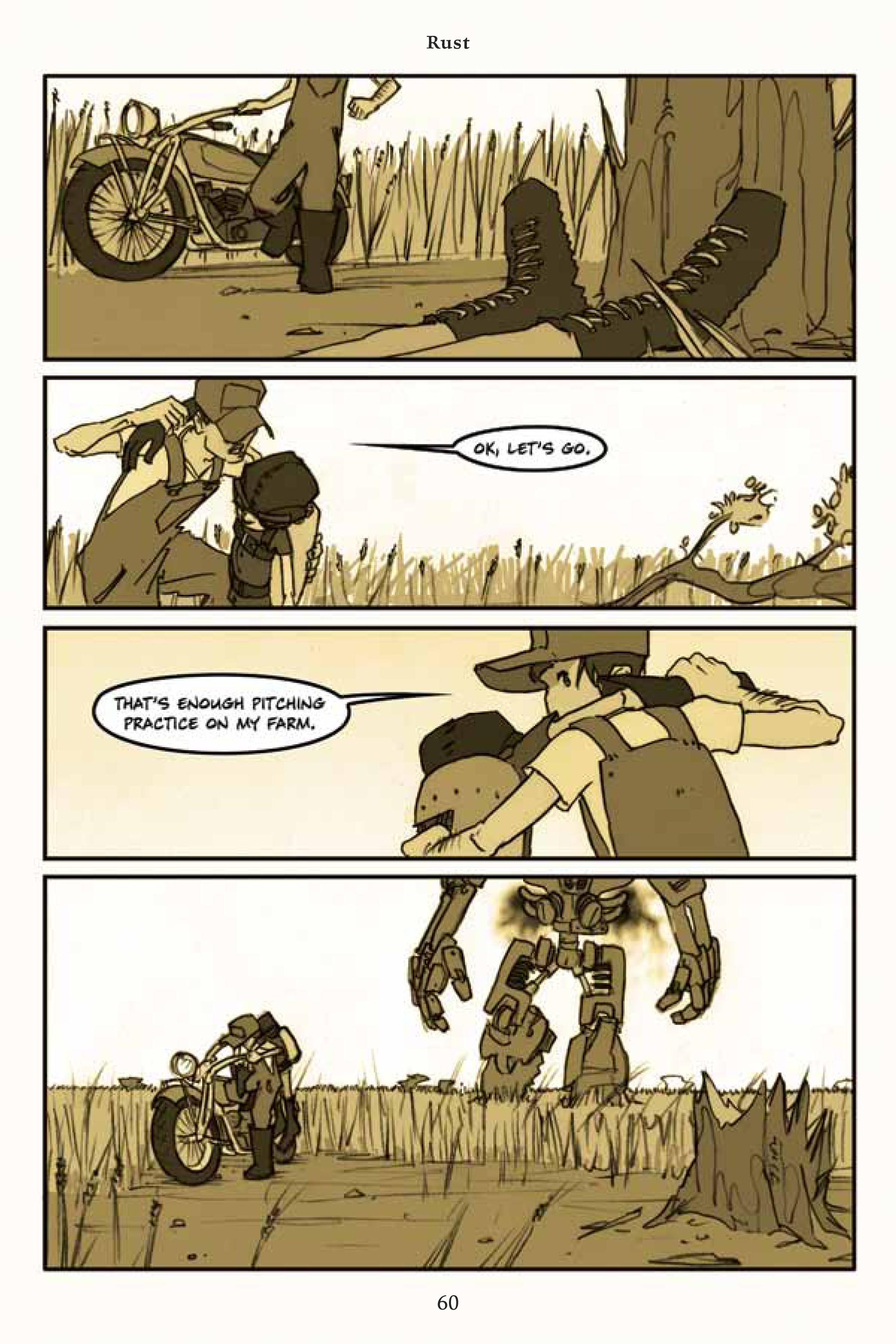 |
| By Royden Lepp courtesy of Archaia.com |
While there are now two Rust books, it appears there will be four volumes and a possible movie with 20th Century Fox. In an interview with Comic Book Resources, Lepp reveals that Joe Cornish (Attack the Block, The Adventures of Tintin, Ant-Man) will be the director, working with Aline McKenna (The Devil Wears Prada) as screenwriter.
Overall impressions: Both volumes are brilliantly illustrated in sepia tone which gives the story a Dust Bowl and post World War I feeling and both are in hardcover. Both tell a compelling story of discovery, war, responsibility, and empowerment. Both really make you think about the characters, their stories, and the challenges of "coming of age."
And, while both books open up with war scenes between jet-propelled 'boys,' large 30-foot mechanical drone monstrosities, and men; and while both contain a super-hero aspect, the story is more about family than about war, robots, or superheroes. In both books, Roman (and in the second book Roman's little brother Oswald) write letters to their dad who is still away (we assume at war), and both books emphasize Roman and Oswald's sense of responsibility to the farm, family and to each other. There are subplots:
- Addressing life with advancing technologies in AI (artificial intelligence) and the balancing roles of humans vs. machines (including farm work and drone warfare). For more on this, please read a post by Stuart Warren (3/14/2013 at sequart.org) "A Unwlecomed Visitation: A Treatment of Drone Warfare in Royden Lepp's Rust"
- Furthermore, while RUST takes place on a farm in what looks like Dust Bowl Oklahoma, the reader is unsure if the land became barren because of environmental issues or as the result of neglect and drone infantry combat.
Volume 1 Rust: Visitor in the field is about a teenager, Roman Taylor who, while living in an alternate world/time, lives in what looks like the Dust Bowl Oklahoma (in an alternate world) in the 1930's that is recovering from what looks like World War I. His father was called to war and Roman is struggling to keep their small farm solvent. Then one day, Jet Jones crash-lands on the farm. As Roman learns more about Jet, discovering how Jet works and Jet's past, Roman becomes more hopeful about his future and the welfare of his family and their farm. So hopeful, that he tends to overlook nagging questions about Jet that remain unanswered.
When Jet Jones first appears, he is fighting a larger rogue machine. Roman helps Jones defeat the larger drone and secures him as a farm hand helping with the harvest and with rebuilding a disabled Model-C robot (which in turn will add more helping hands on the farm) so Oswald can return to school. Oswald is beginning to ask questions of the past, of war, and is questioning who Jet Jones is.
 |
| Rust: Secrets of the Cell by Royden Lepp; courtesy of Archaia |
 |
| Rust: Secrets of the Cell. Royden Lepp, Archaia |
The book opens 48 years in the past where we get a glimpse of Jet Jones as he 'escapes' his past (as seen in the panels above and to the right). Oswald questions Jet Jones' role and motives, and when talking with neighbor (and retired soldier) Mr. Aicot, Oswald learns more about the war, its use of drones and about Models C's and Jet Jones. The story is beautifully layered and is full of intrigue, tension, and heart as we begin to truly question each of the characters, their roles in the farm, in the war, and with each other.
Classroom Suggestions: As these books are appropriate for all ages, classroom suggestions become more layered. I would recommend that these volumes be used by students grades 4+
For middle-school learners:
- Discuss what it was like living in Dust Bowl of the 1930's.
- You may want to compare this book to Karen Hesse's Out of the Dust [by Karen Hesse is about a girl, living in the Dust Bowl who suffers a debilitating accident shortly after the death of her mother, and must learn to face life's harsh lessons with patience and grace. This novel is written solely in prose and poetry and the author's use of language is breathtaking].
- You can discuss the different story-telling aspects of prose, poetry and image.]or to the famous and powerful photographs of Dorothea Lange
- Discuss the role of family, responsibility and issues of 'coming of age'
- Discuss the role of heroes vs. anti-heroes
For high school learners these books might be read when discussing
- War and its effect on families, farms, civilians;
- AI - Artificial intelligence: where we are today, its possibilities, the pros and cons of using AI in our daily lives;
- Drone warfare
- The changing roles of heroes and anti-heroes;

Visitor In the Field. Royden Lepp (Archaia)
Common Core State Standards that can be addressed when reading these books:
- Key Ideas and Details:
- Recount details;
- Quote accurately from the text when explaining content;
- Compare and contrast character motivations or plot development between the two volumes;
- Discuss the central versus secondary themes;
- Analyze how particular elements of the story's drama interact, and/or the role of dialogue versus visual story-telling.
- With limited text this may help weak readers, although the limited text also expands inference making as readers must gather their data by analyzing and integrating visual messages along with text.
- Craft and Structure: in this graphic novel, we are experiencing the story as it unfolds from each character's perspective. This is a wonderful tool for teaching the difference betweeen 1st-person and 3rd-person perspectives.
- Integration of Knowledge and Ideas: interpreting information presented visually and explain how the information contributes to understanding the text (gr. 4), drawing information from multiple print sources (gr. 5), Comparing these books to others on similar topics also falls under the CCSS for this area.
- Roman and Oswald write letters to their father. You might have students write letters to members of their own families who are far away, or you may have them write letters to "Mr. Taylor" from Roman and/or Oswald's perspective (Conventions of Standard English, Knowledge of Language, Vocabulary Acquisition and Use, )
- Have students write a research paper on drone warfare and/or artificial intelligence (Research to Build and Present Knowledge all grades)
- Have students write an opinion piece addressing the pros or cons of using drone warfare (addressing Text Types and Purposes of the CCSS for all grades)
- Range of Reading and Level of Text Complexity -can be addressed when pairing these books with other fiction and non-fiction works about artificial intelligence, the Dust Bowl, and/or drone warfare.
- Have students role play, acting out important parts or decisions of the book (Comprehension and Collaboration)
- Have students present and discuss their research projects (see above) (Presentation of Knowledge and Ideas)
Thanks, as always, for your visit.
Please leave your impressions and reactions, or other pairing/lesson suggestions in the comments.
 |
| From Rust: Secrets of the Cell. By Royden Lepp, Archaia |
Thank you for this Dr. Jaffe! I just got back from a school book tour, I wish I had had this post to pass out to teachers while I was there.
ReplyDeleteMy favorite fans are Teachers and Librarians. :)
-Royden
It was my absolute pleasure - these are great books...and I wish you had had this post to pass out too LOL :-)
ReplyDeleteThanks for the visit and comment!!
Great review and I love the illustrations you included. Carver, ABC Wed. Team
ReplyDeleteMaybe I'll get these for the daughter!
ReplyDeleteROG, ABC Wednesday team
Never heard of this series...looks interesting :)
ReplyDeleteThanks for sharing for WW!
Thank you for this interesting post. I haven't heard of these books before. Are they like the books by John Wyndham?(the Day of the Triffids, The Crysalids, The Midwich Cuckoos, Trouble with Lichen) or any of the Aldous Huxley books?
ReplyDeleteI liked all those books. They are exciting and surprisingly new. Anyway: great post for the letter R!
Wil, ABCW Team.
Thank you for such an interesting post!I am new from southern charm! I would love for you to check out my blog and follow me back! Nicole!
ReplyDeleteI'm your newest follower from Wordless Wednesday Hop. It's going to be fun diving into your blog!
ReplyDeleteCharity
http://humboldtcherry.blogspot.com
That sounds quite intriguing! It's good to learn about the past, even if it's not in a history class!
ReplyDeleteFantastic review I have a five year old I will certainly investigate this =)
ReplyDelete